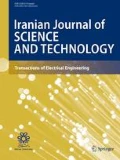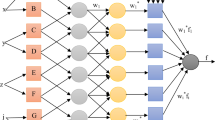Abstract
It is important to forecast the wind speed range for managing the operation of wind turbines (WTs). Since the electrical power generated by WTs is highly dependent on the uncertain inherent of atmosphere meteorology, improving the accuracy of wind speed range forecasting models leads to the improvement of wind generation prediction. For the sake of uncertainties, it is very challenging to develop an effective and practical model to achieve accurate wind speed range forecasting in large forecasting horizons. This paper presents a novel hybrid classifier based on extended-classifier system with real input (XCSR) and an adaptive neuro-fuzzy inference system (ANFIS), for classification of the wind speed range. It should be mentioned that by employing a cooperative fuzzy classifier system (XCSR–ANFIS), the accuracy and number of the rules that XCSR system must be learned during the training process in the proposed model will be higher and fewer than the XCSR model, respectively. Finally, the comparison of obtained results by implementing the proposed model with other methods for long and short horizons confirms the desirable performance of the proposed model.










Similar content being viewed by others
References
Aasim SSN, Mohapatra A (2019) Repeated wavelet transform based ARIMA model for very short-term wind speed forecasting. Renew Energy 136:758–768
Abbasi E, Naghavi N (2017) Offline auto-tuning of a PID controller using extended classifier system (XCS) algorithm. J Adv Comput Eng Technol 3(1):41–50
Ali M, Khan A, Rehman N (2017) Hybrid multiscale wind speed forecasting based on variational mode decomposition. Int Trans Electr Energ Syst. https://doi.org/10.1002/etep.2466
Butz M (2007) Combining gradient-based with evolutionary online learning: an introduction to learning classifier systems. In: Proceedings of the international conference on hybrid intelligent systems
Cadenas E, Rivera W, Campos-Amezcua R, Heard C (2016) Winds peed prediction using a univariate ARIMA model and a multivariate NARX model. Energies 9(2):109
Cao Q, Ewing BT, Thompson MA (2012) Forecasting wind speed with recurrent neural networks. Eur J Oper Res 221(1):148–154
Castronuovo ED, Lopes JAP (2004) On the optimization of the daily operation of a wind hydro power plant. IEEE Trans Power Syst 19(3):1599–1606
Chang GW, Lu HJ, Wang PK, Chang YR, Lee YD (2017) Gaussian mixture model-based neural network for short-term wind power forecast. Int Trans Electr Energ Syst. https://doi.org/10.1002/etep.2320
Dhiman HS, Deb D, Guerrero JM (2019) Hybrid machine intelligent SVR variants for wind forecasting and ramp events. Renew Sustain Energy Rev 108:369–379
Doherty R, O’Malley M (2003) Quantifying reserve demands due to increasing wind power penetration. In: Proceedings of the International Conference IEEE Power Tech Bologna, Italy
Doucoure B, Agbossou K, Cardenas A (2016) Time series prediction using artificial wavelet neural network and multi-resolution analysis: application to wind speed data. Renew Energy 192:202–211
Eseye AT, Zhang J, Zheng D, Ma H, Jingfu G (2017) A double-stage hierarchical ANFIS model for short-term wind power prediction. In: Proceedings of the international conference big data analysis
EWEA (2015) Wind energy scenarios for 2030′, reported by the European Wind Energy Association
Feng C, Cui M, Hodge BM, Zhang J (2017) A data-driven multimodel methodology with deep feature selection for short-term wind forecasting. Appl Energy 190(15):1245–1257
Finamore AR, Calderaro V, Galdi V, Piccolo A, Conio G, Grasso S (2015) A day-ahead wind speed forecasting using data-mining model-a feedforward NN algorithm. In: International conference on renewable energy research and applications
Firat U, Engin SN, Saraclar M, Ertuzun AB (2010) Wind speed forecasting based on second order blind identification and autoregressive model. In: Proceedings of the international conference machine learning and applications, Washington
Holland JH (1975) Adaptation in natural and artificial systems: an introductory analysis with applications to biology, control, and artificial intelligence. University of Michigan Press, Ann Arbor
Holland JH (1986) A mathematical framework for studying learning in classifier systems. Phys D 22(1):37–317
Holmes JH, Lanzi PL, Stolzmann W, Wilson SW (2002) Learning classifier systems: new models, successful applications. Inf Proces Lett 82:23–30
Hossin M, Sulaiman MDN, Mustapha A, Mustapha N (2011) A novel performance metric for building an optimized classifier. J Comput Sci 7(4):582–590
Hu YL, Chen L (2018) A nonlinear hybrid wind speed forecasting model using LSTM network, hysteretic ELM and differential evolution algorithm. Energy Convers Manage 173:123–142
Hu Q, Su P, Yu D, Liu J (2014) Pattern-based wind speed prediction based on generalized principal component analysis. IEEE Trans Sust Energy 5(3):866–874
Jiang P, Yang H, Heng J (2019) A hybrid forecasting system based on fuzzy time series and multi-objective optimization for wind speed forecasting. Appl Energy 235:786–801
Kecman V (2001) Leaning and soft computing support vector machines, neural networks, and fuzzy logic models. MIT Press, Cambridge
Kehe W, Yue Y, Bohao C, Jinshui W (2013) Research of wind power prediction model based on RBF neural network. In: Proceedings international conference computational and information sciences
Khosravi A, Machado L, Nunes RO (2018) Time-series prediction of wind speed using machine learning algorithms: a case study Osorio wind farm, Brazil. Appl Energy 224:550–566
Kostas P, Deligiorgi D (2012) Application of artificial neural networks for the spatial estimation of wind speed in a coastal region with complex topography. Renew Energy 1:75–82
Kovacs T (1996) Evolving optimal populations with XCS classifier systems. Master’s thesis, University of Birmingham U.K.
Lee D, Baldick R (2014) Short-term wind power ensemble prediction based on gaussian processes and neural networks. IEEE Trans Smart Grid 5(1):501–510
Li H, Wang J, Lu H, Guo Z (2018) Research and application of a combined model based on variable weight for short term wind speed forecasting. Renew Energy 116:669–684
Ling-Ling L, Li JH, He PJ, Wang CS (2011) The use of wavelet theory and ARMA model in wind speed prediction. In: Proceedings of the international conference electric power equipment-switching technology
Liu Z (2014) Wind speed forecasting model based on fuzzy manifold support vector machine. J Inf Comput Sci 11(7):2387–2395
Liu H, Tian HQ, Pan DF, Li YF (2013) Forecasting models for wind speed using wavelet, wavelet packet, time series and Artificial Neural Networks. Appl Energy 107:191–208
Lu P, Ye L, Sun B, Zhang C, Zhao Y, Teng J (2018) A new hybrid prediction method of ultra-short-term wind power forecasting based on EEMD-PE and LSSVM optimized by the GSA. Energies 11(4):697
Ma L, Shiyan L, Chuanwen J, Hongling L, Yan Zhang Y (2009) A review on the forecasting of wind speed and generated power. Renew Sust Energy Rev 13(4):915–920
Manyonge AW, Ochieng RM, Onyango FN, Shichikha JM (2012) Mathematical Modelling of Wind Turbine in a Wind Energy Conversion System Power Coefficient Analysis. Appl Math Sci 6(91):4527–4536
Sabzehzar A, Shana WL, Shariat PM, Saremi O (2015) An improved extended classifier system for the real-time-input real-time-output (XCSRR) stability control of a biped robot. Procedia Comput Sci 61:492–499
Shi J, Ding Z, Lee WJ, Yang Y, Liu Y, Zhang M (2014) Hybrid forecasting model for very-short term wind power forecasting based on grey relational analysis and wind speed distribution features. IEEE Trans Smart Grid 5(1):521–526
Song J, Wang J, Lu H (2018) A novel combined model based on advanced optimization algorithm for short-term wind speed forecasting. Appl Energy 215:643–658
Vahidinasab V, Jadid S (2010) Bayesian neural network model to predict day-ahead electricity prices. Euro Trans Elec Power. 20(2):231–246
Vahidinasab V, Vafa HS (2018) Wind power forecasting by a new hybrid forecast engine composed of GA/EPSO-based mutual information and group method of data handling (GMDH). Comput Int Electron Eng 2:1–14 (In Persian)
Vahidinasab V, Jadid S, Kazemi A (2008) Day-ahead price forecasting in restructured power systems using artificial neural networks. Elec Power Syst Res. 78(8):1332–1342
Wang J, Du P, Niu T, Yang W (2017) A novel hybrid system based on a new proposed algorithm—Multi-objective whale optimization algorithm for wind speed forecasting. Appl Energy 208:344–360
Wilson SW (1995) Classifier fitness based on accuracy. Evol Comput 3(2):149–175
Wilson SW (1998) Generalization in the XCS classifier system. In: Proceedings conference in genetic programming, Morgan Kaufmann. San Francisco
Wilson SW (2000) Get real! XCS with continuous-valued inputs. Learn Classif Syst 15:209–219
Zhang W, Wang J, Wang J, Zhao Z, Tian M (2013) Short-term wind speed forecasting based on a hybrid model. Appl Soft Comput 13(7):3225–3233
Zhang C, Zhou J, Li C, Fu W, Peng T (2017) A compound structure of ELM based on feature selection and parameter optimization using hybrid backtracking search algorithm for wind speed forecasting. Energy Convers Manage 143:360–376
Zhao X, Wang S, Li T (2011) Review of evaluation criteria and main methods of wind power forecasting. Energy Procedia 12:761–769
Author information
Authors and Affiliations
Corresponding author
Rights and permissions
About this article
Cite this article
Alipour, M., Aghaei, J., Norouzi, M. et al. A Novel Cooperative Fuzzy Classifier for Predicting the Permissible Wind Speed Range in Wind Farms. Iran J Sci Technol Trans Electr Eng 45, 29–45 (2021). https://doi.org/10.1007/s40998-020-00347-z
Received:
Accepted:
Published:
Issue Date:
DOI: https://doi.org/10.1007/s40998-020-00347-z




